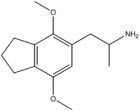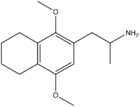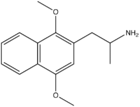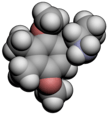Ganesha (psychedelic)
| |||
| Names | |||
|---|---|---|---|
| IUPAC name
2-(2,5-Dimethoxy-3,4-dimethyl-phenyl)-1-methyl-ethylamine | |||
| Other names
3,4-Dimethyl-2,5-dimethoxyamphetamine; 2-(3,4-Dimethyl-2,5-dimethoxyphenyl)-1-methyl-1-aminoethane | |||
| Identifiers | |||
3D model (JSmol) |
|||
| ChEMBL | |||
| ChemSpider | |||
| |||
| |||
| Properties | |||
| C13H21NO2 | |||
| Molar mass | 223.31 g·mol−1 | ||
Except where otherwise noted, data are given for materials in their standard state (at 25 °C [77 °F], 100 kPa). | |||
| Infobox references | |||
Ganesha, or 2,5-dimethoxy-3,4-dimethylamphetamine, is a lesser-known psychedelic drug. It is also a substituted amphetamine. It was first synthesized by Alexander Shulgin. In his book PiHKAL (Phenethylamines i Have Known And Loved), the dosage range is listed as 24–32 mg. The drug is usually taken orally, although other routes such as rectally may also be used. Ganesha is synthesized from 2,5-dimethoxy-3,4-dimethylbenzaldehyde. Ganesha is the amphetamine analogue of 2C-G. It is a particularly long lasting drug, with the duration listed in PiHKAL as being 18 – 24 hours, which might make it undesirable to some users. It is named after the Hindu deity, Ganesha. Very little is known about the dangers or toxicity of Ganesha. Effects of Ganesha include:
- Strong closed-eye visuals
- An increased appreciation of music
- Powerful relaxation and tranquility
Homologues
G-3

2,5-Dimethoxy-3,4-(trimethylene)amphetamine
Dosage: 12–18 mg
Duration: 8-12 h
Effects: Enhancement of reading, no visuals or body load.
G-4

2,5-Dimethoxy-3,4-(tetramethylene)amphetamine
Dosage: unknown
Duration: unknown
Effects: unknown
G-5
3,6-Dimethoxy-4-(2-aminopropyl)benzonorbornane
Dosage: 14–20 mg
Duration: 16-30 h
G-N

1,4-Dimethoxynaphthyl-2-isopropylamine
Legality
United Kingdom
This substance is a Class A drug in the Drugs controlled by the UK Misuse of Drugs Act.[1]
See also
References
- ↑ "UK Misuse of Drugs act 2001 Amendment summary". Isomer Design. Retrieved 12 March 2014.

